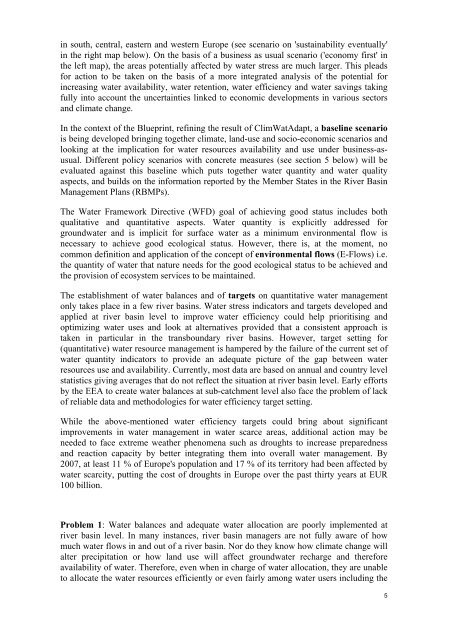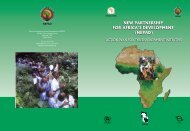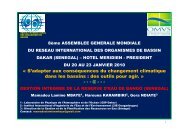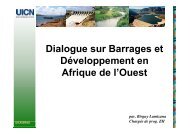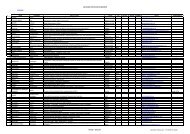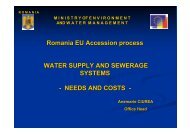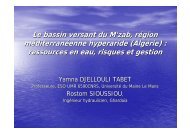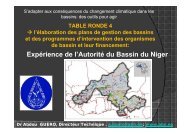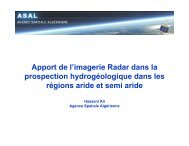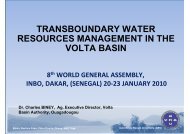background consultation document - European Commission - Europa
background consultation document - European Commission - Europa
background consultation document - European Commission - Europa
You also want an ePaper? Increase the reach of your titles
YUMPU automatically turns print PDFs into web optimized ePapers that Google loves.
in south, central, eastern and western Europe (see scenario on 'sustainability eventually'<br />
in the right map below). On the basis of a business as usual scenario ('economy first' in<br />
the left map), the areas potentially affected by water stress are much larger. This pleads<br />
for action to be taken on the basis of a more integrated analysis of the potential for<br />
increasing water availability, water retention, water efficiency and water savings taking<br />
fully into account the uncertainties linked to economic developments in various sectors<br />
and climate change.<br />
In the context of the Blueprint, refining the result of ClimWatAdapt, a baseline scenario<br />
is being developed bringing together climate, land-use and socio-economic scenarios and<br />
looking at the implication for water resources availability and use under business-asusual.<br />
Different policy scenarios with concrete measures (see section 5 below) will be<br />
evaluated against this baseline which puts together water quantity and water quality<br />
aspects, and builds on the information reported by the Member States in the River Basin<br />
Management Plans (RBMPs).<br />
The Water Framework Directive (WFD) goal of achieving good status includes both<br />
qualitative and quantitative aspects. Water quantity is explicitly addressed for<br />
groundwater and is implicit for surface water as a minimum environmental flow is<br />
necessary to achieve good ecological status. However, there is, at the moment, no<br />
common definition and application of the concept of environmental flows (E-Flows) i.e.<br />
the quantity of water that nature needs for the good ecological status to be achieved and<br />
the provision of ecosystem services to be maintained.<br />
The establishment of water balances and of targets on quantitative water management<br />
only takes place in a few river basins. Water stress indicators and targets developed and<br />
applied at river basin level to improve water efficiency could help prioritising and<br />
optimizing water uses and look at alternatives provided that a consistent approach is<br />
taken in particular in the transboundary river basins. However, target setting for<br />
(quantitative) water resource management is hampered by the failure of the current set of<br />
water quantity indicators to provide an adequate picture of the gap between water<br />
resources use and availability. Currently, most data are based on annual and country level<br />
statistics giving averages that do not reflect the situation at river basin level. Early efforts<br />
by the EEA to create water balances at sub-catchment level also face the problem of lack<br />
of reliable data and methodologies for water efficiency target setting.<br />
While the above-mentioned water efficiency targets could bring about significant<br />
improvements in water management in water scarce areas, additional action may be<br />
needed to face extreme weather phenomena such as droughts to increase preparedness<br />
and reaction capacity by better integrating them into overall water management. By<br />
2007, at least 11 % of Europe's population and 17 % of its territory had been affected by<br />
water scarcity, putting the cost of droughts in Europe over the past thirty years at EUR<br />
100 billion.<br />
Problem 1: Water balances and adequate water allocation are poorly implemented at<br />
river basin level. In many instances, river basin managers are not fully aware of how<br />
much water flows in and out of a river basin. Nor do they know how climate change will<br />
alter precipitation or how land use will affect groundwater recharge and therefore<br />
availability of water. Therefore, even when in charge of water allocation, they are unable<br />
to allocate the water resources efficiently or even fairly among water users including the<br />
5


